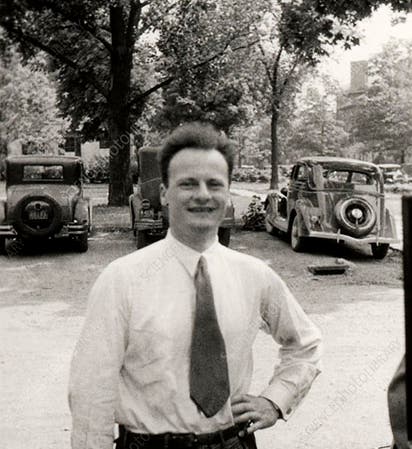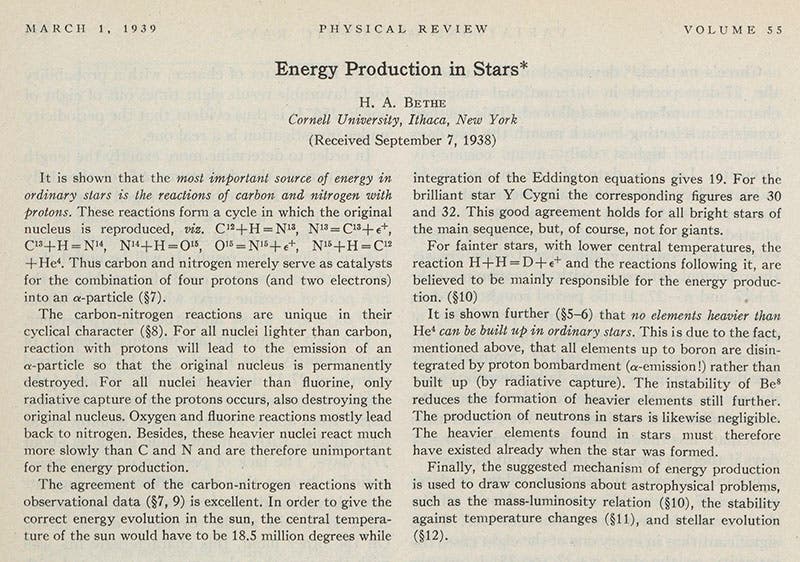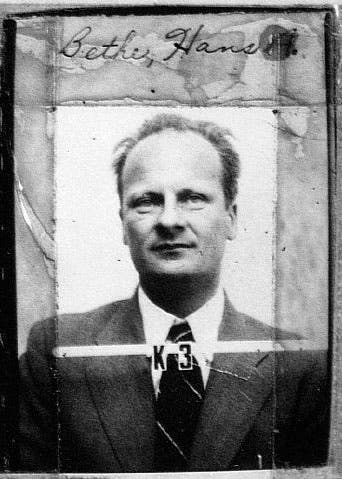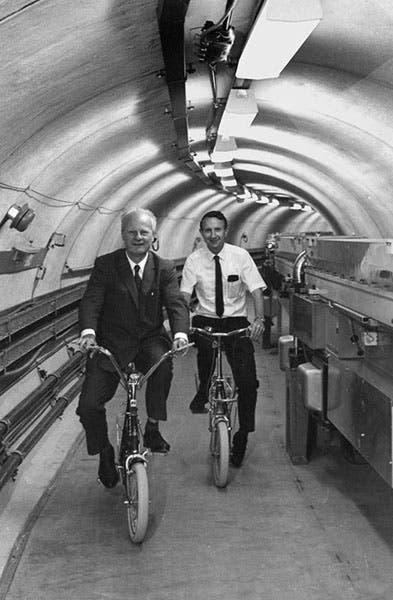Scientist of the Day - Hans Bethe
Hans Bethe, a German/American physicist, was born July 2, 1906. Germany was at the forefront of quantum physics in the late 1920s, with the likes of Max Planck, Wolfgang Pauli, and Werner Heisenberg teaching at various German universities; Bethe studied with Arnold Sommerfeld at Munich, and managed to get a teaching position at Tübingen. But in 1933, the world turned upside down as the Nazis came to power, and Bethe, who was Jewish, lost his job and fled to England. In 1935, Bethe came to the United States, and he seemed very happy to be here, if a photo taken that year is any indication (first image). He accepted an invitation to teach and work at Cornell, a position he held for 40 years and a place he called home for 70 (Bethe lived to be 98!).
It was in his third year at Cornell that Bethe made perhaps his most famous discovery. He had attended a conference where the energy source of the sun was the main topic, and much of the discussion, in Bethe’s opinion, was uninformed rubbish. So he took the train home to Ithaca, and on the way back, he told himself, “I can do that!” And within a short time, he had indeed done it. He was able to demonstrate mathematically that in the core of the sun, the temperature would be hot enough to support the fusion of hydrogen into helium. He showed there were two possible reactions that would lead to the production of helium – one for stars like the Sun, another for moe massive stars. He further showed that the fusion of a helium atom from hydrogen atoms results in a slight loss of mass. Using Einstein's famous formula, E = mc2, he could predict that the missing mass would emerge in the form of energy – a prodigious amount of energy, since the quantity c-squared is an 11-digit number. Bethe was able to calculate the amount of energy that the Sun would produce in its core by such a fusion process, and it turned out to be just the observed amount. For this discovery, announced in 1939 (second image), Bethe would receive the Nobel Prize in Physics in 1967.
Bethe also played an important role in the Manhattan Project, 1942-46, being in charge of the theoretical physicists at Los Alamos, the ones who predicted what would happen when you took hemispheres of uranium or plutonium and forced them, one way or another, into a critical mass. We see here Bethe’s photo, as it appeared on his Los Alamos ID card (third image). The calculations were extremely difficult, in the days before calculators, much less computers, and Bethe was apparently the greatest calculator of them all. Richard Feynman, who was 12 years younger than Bethe and a team leader under Bethe at Los Alamos, was renowned as the possessor of uncanny calculating skills, but in his first memoir, Surely You're Joking, Mr. Feynman, he confessed that he couldn't hold a candle to Bethe, who could perform unreal calculations in his head. Feynman was so impressed with Bethe’s abilities that he followed him back to Cornell in 1946 after the end of the War and taught there for 6 years before heading off to do his own thing at Cal Tech.
One of the great Bethe stories is one where Bethe played only a passive role, but it is worth relating nevertheless. In 1948, Ralph Alpher and George Gamow at Georgetown University had written a paper on the origin of the elements, in which the idea of the Big Bang was assumed, and Gamow, an incorrigible prankster, realized that “Alpher and Gamow” sounded a lot like “alpha and gamma”, the first and third letters of the Greek alphabet, and he thought that the author line would have a nicer ring if it included a “beta” as well. So when he sent the paper in to Physical Review, he simply added Hans Bethe’s name as a third author. Bethe was one of the reviewers of the paper, and rather than take offense, he was tickled to death that his name was part of what was obviously going to be a very important paper, and he didn’t have to do a bit of work. Alpher, on the other hand, who was just a graduate student at the time, was extremely miffed, afraid that his own contribution would be overshadowed by the luster of Bethe’s name. We see here the opening page of the famous “Alpha-Beta-Gamma” paper of 1948 (fourth image).
Our other photos show Bethe receiving his Nobel Prize in 1967 in Stockholm (fifth image) and cycling in the circular track of the super collider at Cern (sixth image).
Bethe was one of the most conscientious of physicists, opposing the arms race in the 1960s and 70s, and speaking out publicly against the folly of Reagans’ SDI proposal of the 1980s. He wrote his last important paper when he was nearly ninety years old. There have not been many physicists with the mental longevity of Hans Bethe.
Dr. William B. Ashworth, Jr., Consultant for the History of Science, Linda Hall Library and Associate Professor, Department of History, University of Missouri-Kansas City. Comments or corrections are welcome; please direct to ashworthw@umkc.edu.











